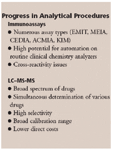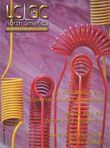Profiles in Practice Series: A Revolution in Clinical Chemistry
LCGC North America
The applications of mass spectroscopy to clinical chemistry are discussed with the help of this month's featured scientists.
Mass spectrometry (MS) might not be the first technique you would associate with clinical chemistry practice. More likely, you would think of automated clinical chemistry analyzers. Or you might consider any of a variety of immunoassay-based techniques like chemiluminescent immunoassay (CLIA), enzyme linked iunosorbent assay (ELISA), or microparticle enzyme immunoassay (MEIA). Dr. Catherine Hammett-Stabler (University of North Carolina, Chapel Hill) aptly characterizes the nature of clinical practice:

Michael P. Balogh
Clinical chemistry laboratories are expected to handle thousands of samples each day. Since the number of analyses associated with each sample varies from one to over 20, automation is the key to efficiently performing the requested testing with minimal errors. Remember, a patient's diagnosis and treatment is based upon our test results.
Add government regulatory oversight to the technical demands clinical lab chemists face, and you would not expect them to reflexively embrace MS.
That has been changing in recent years. Liquid chromatography–mass spectrometry (LC–MS) has evolved to a point where software and hardware platforms are well-integrated and rugged. This evolution, already significant in its effect on other areas of analytical chemistry, will continue to influence clinical practice. This is particularly true for monitoring the efficacy of therapeutic drugs, patient monitoring in clinical evaluations, and detection of drugs of abuse.

Clinical chemistry practice bears many similarities to analytical practice in drug discovery, especially in the need for high throughput and precise determinations from complex, typically physiological matrixes. Thus, the LC–MS instruments in use are, primarily, highly sensitive, triple quadrupole mass spectrometers (LC–MS-MS). Moreover, to combat ion suppression and other interferences such as unexpected fragmentation of drug metabolites, which can impede characterization in the process (1), both require practitioners to exercise great care when performing chromatographic separations and preparing samples.
Wide acceptance of LC–MS results is opposed by long-standing practice based upon interpreting immunoassay results. In a recent presentation, Professor Oellerich offered this comparison of the two methods.
Despite the accuracy and specificity afforded by LC–MS, physicians who use the data are often more familiar with immunoassay-based results. Immunoassays use antigen-antibody reactions to measure the concentrations of many drugs, hormones, and peptides in body fluids such as blood, serum, or urine. Unfortunately, other compounds whose structures are similar to that of a compound of interest can trigger a similar antibody response and interfere with the desired measurement. When a clinical laboratory makes a change from these types of methods to one of greater specificity, they will have to re-determine their reference or therapeutic ranges. Since treatment protocols are often based upon these ranges, this means the laboratory must work closely with the clinician so that the protocols can be adjusted or changed.
Dosing regimens in immunosuppressive practice are often complicated by therapeutic agents, which are used in widely differing concentrations. The high cross-reactivity of variable concentrations of immunosuppressive drug metabolites biased by the presence of inactive metabolites could compromise appropriate dosage adjustments. In Prof. Oellerich's experience, a comparison between the MEIA and LC–MS-MS assay for a patient taking the immunosuppressant sirolimus may exhibit significant variability. He finds an average bias of 26% favoring LC–MS-MS, and he sees much higher deviations in individual patients, the result of metabolic cross-activity. LC–MS analysis obviates the need to cope with this particularly troublesome shortcoming of the traditional assay.

Featured Scientists
As the use of immunosuppressive therapies increased, the practice triggered a related increase in the use of low-dose calcineurin inhibitor (CNI) regimens. But the sensitivity limitations of current immunoassays make monitoring trough concentrations uncertain, a limitation that doesn't exist in LC–MS-MS. Also, though immunoassay sample dilutions frequently cause immunosuppressive drug monitoring problems, the broadly calibrated range an LC–MS-MS analysis usually makes sample dilution unnecessary.
LC–MS works well for simultaneous determinations of many drugs. It exhibits high selectivity and, compared with traditional methods, greatly improved sensitivity to far lower concentrations. Moreover it is less prone to spurious results. As Professor Oellerich points out, a sample taken from a patient whose hematocrit values are low (< 25%) can cause false immunoassay results, as is the case when MEIA is used for Tacrolimus determinations.
Nevertheless, the major advantage of adopting LC–MS-MS is its high specificity, accuracy, and precision. A more rational, individualized dosage based on the concentration of a specific parent drug is possible. Also, direct costs are more than 50% lower than immunoassay costs. A wide variety of samples are suitable to LC–MS analysis, and although the initial capital outlay is higher for LC–MS than for immunoassay, the daily operating costs are lower (2,4). Immunoassays offer high potential for automation but LC–MS in addition promises freedom from the shackles of commercial, proprietary assays.
The expertise to perform LC–MS is not a requirement easily waived. St. Olav's Hospital in Norway offers ample evidence that using single quadrupole instruments is feasible. Such instruments are conceptually closer to the simple analyzer and therefore when able to be employed in specific instances require less expertise than LC–MS-MS provided proper attention is given to the chromatography (3). With a dozen redundant systems running over five years it appears to be a well-documented case.

Progress in Analytical Procedures
An increasingly available and attractive clinical analysis method, LC–MS nevertheless fails to directly benefit from the knowledge and experience of clinicians steeped in the immunoassay tradition. Therapeutic target ranges derived from immunoassay-based methods might not apply, and studies correlating concentrations with clinical efficacy may be lacking. Target ranges for newer drugs must be developed, necessitating studies of the relationship between serum concentrations and clinical efficacy. Such studies must be based on pharmacokinetic properties and modes of action, as a considerable overlap in drug concentrations related to toxicity and nonresponse can exist (4).
We can divide drug monitoring methods according to the major therapeutic categories: immunosuppressive, antiretroviral, antiepileptic, antibiotic, cardiac, and antidepressant. Prof. Oellerich notes that, in the United States, induction therapy is more frequently used than it is in Europe. He goes on to say, however, that American and European monitoring practice for immunosuppressant drugs is similar during the induction phase and maintenance therapy.
Detecting unknowns is typically more demanding than testing for specific targets. But even mixtures of drugs that include a target can cause problems. The main culprit is often suppression of the target (or targets) by the matrix. The extraction step can be optimized using solid phase extraction (SPE) and protein precipitation. Doing so further minimizes matrix effects from human blood or artificial quality control material. It may also bring about a shorter analysis time and higher precision of the LC–MS-MS method used. The use of stable, isotope-labeled internal standards can further minimize the influence of matrix effects on results.
Growing Acceptance of LC–MS
The technological argument for adopting newer technologies is irrefutable. A Q-TOF mass spectrometer provides exact mass determinations of analytes from complex matrixes. Moreover, technology such as the Waters ACQUITY UPLC (Ultrahigh Performance Liquid Chromatography) (Milford, Massachusetts), a technology seen to be displacing traditional HPLC, is seen by many to enhance MS performance (5).
In the hands of most knowledgeable practitioners, an S/N of 15:1 is typical. Nevertheless, 50:1 is the goal for high-throughput, automated use and to extend instrument usability to less knowledgeable operators. The latest technologies, such as ultrahigh pressure liquid chromatography, deliver not only enhanced throughput through shorter run times but also better defined, narrow peak widths resulting in increased S/N. That such instruments can resolve unique entities from the competitive matrix is considered an important recent innovation.
The quadrupoles typically employed in clinical chemistry today, such as the Waters Quattro Micro or the API 2000 from Sciex (Concord, Ontario, Canada), can develop sufficient data points in numerous multiple reaction monitoring (MRM) windows to track the critical identifying fragmentation transition of each analyte despite the narrow peaks (6). Among other needs often cited as critical in their practice, clinical chemists include added column stability for use with common derivatives (acids, for instance) from pH 1 through pH 12, and an ability to handle effective column loads with improved resolution because current practice often uses 50 μL injections (down to 10 μL for pediatrics).
Are the benefits of higher mass accuracy and increased resolution cost-effective?: High-resolution instruments prove indispensable in proteomics, peptide identification, and the characterization of drug metabolite structures. A Q-TOF instrument's ability to measure infinitesimal differences — sometimes referred to as mass defects (the numerous hydrogen atoms associated with a molecule, which have an atomic mass of 1.007825 Da, are not simply "1" as we assume in unit mass applications) — against a theoretically correct exact mass improves the accuracy when measuring multiple targets in highly diverse samples. Consider, as a theoretical example, an analyte of mass 400.000 that deviates no more than 400.002 when measured in a mass spectrometer. Such a measurement is said to be accurate to 5 ppm (the measured value divided by true mass times 106). You can use a simple algorithm (downloaded from any of several Internet sites) created by James Deline (7) to limit the number of possible chemical formulas of this theoretical compound. Thus, even without knowledge of the compound's constituent atoms, you can decrease the number of possible chemical formulas from 22 to 9 by narrowing the acceptable accuracy of your measurement from 400.005 to 400.002 (a tolerance for 5 ppm error). Most practitioners would agree that the greater-than-50% reduction of possibilities is desirable but might argue its cost-effectiveness, especially for target analysis. In practice, Dr. Oellerich avers, instruments such as the Quattro Micro triple quadrupole are especially efficient for therapeutic drug monitoring or measuring other analytes such as Vitamin D, homocysteine, or steroid hormones.
A technique that provides an additional degree of surety is based upon evaluating a spectrum's isotope pattern. Typically, a single transition from drug or metabolite ion to a specific fragment ion monitored via LC–MS-MS suffices (although two transitions are preferred when possible). Isotope monitoring can be useful where no second transition ion exists. Dr. Alan Rockwood created algorithms that take advantage of isotope distribution ratios to improve characterization of analytes of interest. Thus, with little more detail than the isotopic pattern in the spectrum associated with the analyte, an instrument capable of sufficient resolution can make effective determinations (8).
Of course, cost is always an issue, and MS involving triple quads is supportable on a reduced-cost argument, though that argument likely does not extend to the high-end hybrids. Appropriate sample preparation is thought to be the most efficient, (that is, the most effective and least-expensive) means to reduce ion suppression. Cost-per-sample is an overriding concern of administrations and insurance providers, both in Europe and the U.S. An unwritten rule states that unless a scientific benefit can be had at relatively low cost, a current technology must stand.
The Future of MS in Clinical Practice
The most immediate bar to achieving improved patient care from the benefits of greatly improved information is the educational barrier between clinicians and the means of presenting information. Medical practice is based upon qualitative judgments bounded by traditional methods. Treatment protocols will need rewriting to reflect the difference in data obtained using MS versus immunoassays.
MS in clinical settings is still fighting traditional assay methods for acceptance and application. Progress often is reversed when comparative studies are flawed by artifacts introduced by the materials used for comparison, as is the case with some immunoassay calibrants. Another problem in these early days is that in some cases outcome studies that show the advantage of using the better quality MS data have not been done yet.
The regulatory oversight in this practice requires that data be produced by certified instrument operators. And so Dr. Hammett-Stabler, Prof. Oellerich, and others in their position face a quandary. Dr. Hammett-Stabler frames the issue:
Should the medical technologists become trained mass spectrometrists or the mass spectrometrists become certified medical technologists? While some of our medical technologists have shied away from mass spectrometry, preferring other challenges, others have embraced it. Our initial goal was that these technologists would be well-trained operators. Now several are working towards becoming mass spectrometrists.
Recent trends support Dr. Hammett-Stabler's observation. Of late, clinical chemistry has revealed itself to be a growth hot-spot for MS. Writing in a recent editorial review (9) citing the practical currency of MS for clinical chemistry, Michael Kinter (Cleveland Clinical Foundation, Case Western Reserve University School of Medicine and Cleveland State University) noted the change in his opinion from a similar review in 1995. Nearly a decade ago, Kinter stated the expectation for MS was limited to "developing nonroutine information about specialized analytes." He characterizes the view today of MS role based upon the reports cited in the review that such assays can be "made routine using the power of robust and reliable mass spectrometry systems to process relatively large numbers of samples." He further suggests that keeping focus on mass spectrometer assays will bring them to clinical application more rapidly and "will retain more of the diagnostic power."
Acknowledgments
The author would like to thank Dr. Catherine Hammett-Stabler (University of North Carolina, Chapel Hill, North Carolina) and Dr. Michael Oellerich (Georg-August University, Gottingen, Germany), two experts in the field of clinical chemistry, for generously contributing to this month's column.
Michael P. Balogh "MS — The Practical Art" Editor Michael P. Balogh is principal scientist, LC–MS technology development, at Waters Corp. (Milford, Massachusetts); an adjunct professor and visiting scientist at Roger Williams University (Bristol, Rhode Island); and a member of LCGC's editorial advisory board.
References
(1) M.P. Balogh, LCGC 23(2), 136–141 (2005).
(2) F. Streit, V. Armstrong, M. Oellerich, Clinical Chemistry 48, 955–958 (2002).
(3) K. Zahlsen, T. Aamo, and J. Zweigenbaum, LCGC 23(4), 384–394 (2005).
(4) S. Johannessen, D. Battino, D. Berry, M. Bialer, G. Kramer, T. Tomson, P. Patsalos, Therapeutic Drug Monitoring 25(3), 347–363 (2003).
(5) J. Castro-Perez, R. Plumb, J. H. Granger, I. Beattie, K. Joncour, A. Wright, Rapid Commun. Mass Spectrom. 19(6), 843–848 (2005).
(6) "Automated LC/MS/MS High Throughput Multi-mode Ionization Quantification Protocol Applied for Microsome Stability Test in Drug Discovery and Development," K. Yu, P. Alden, R. Plumb, L. Di, S. Li, E. Kerns, P. Chilvers, 53rd ASMS Conference, San Antonio, Texas, 2005.
(7) Molecular Fragment Calculator 1.0 (mfcalc), James E. Deline, Windows version Dwight L. Smith.
(8) A.L. Rockwood, S.L. Van Orden, R.D. Smith, Rapid Commun. Mass Spectrom. 10(1), 54–59 (1996).
(9) M. Kinter, Clin. Chem. 50(9), 1500–1502 (2004).

University of Rouen-Normandy Scientists Explore Eco-Friendly Sampling Approach for GC-HRMS
April 17th 2025Root exudates—substances secreted by living plant roots—are challenging to sample, as they are typically extracted using artificial devices and can vary widely in both quantity and composition across plant species.
Thermodynamic Insights into Organic Solvent Extraction for Chemical Analysis of Medical Devices
April 16th 2025A new study, published by a researcher from Chemical Characterization Solutions in Minnesota, explored a new approach for sample preparation for the chemical characterization of medical devices.











